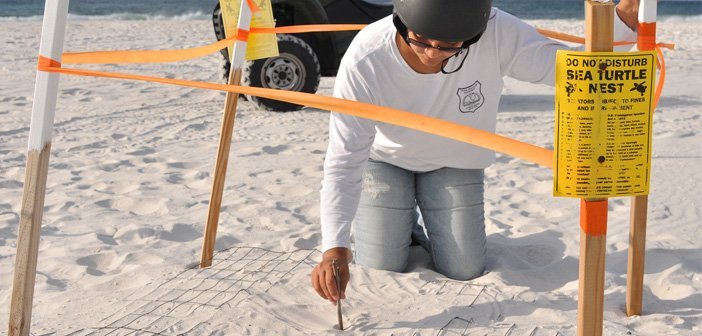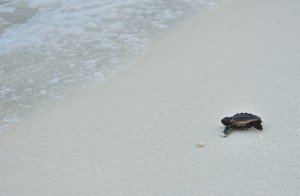The objective is defined and the rendezvous is set for nightfall. Under the cover of darkness, the group moves vigilantly and swiftly through the wetlands and over dunes.
While the gentle sound of waves lapping against the shoreline grows louder, the brittle vegetation and sea oats beneath their feet becomes white sandy quartz as they approach their target… a sea turtle nest.
Members of Eglin’s Sea Turtle Patrol Program, a group of a several biologists and trained volunteers, find and safeguard threatened and endangered sea turtle nests on the base’s Santa Rosa Island range during the vital nesting and hatching period, May to October.
“It’s important to do this and to keep good records; we want to know where the nests are and when the eggs are laid,” said Erica Laine, biologist and volunteer coordinator for Eglin’s Jackson Guard. “This information tells us when the eggs will hatch and the species of turtle as well. The state of Florida uses data from our records, too.”
During daily patrols in the six-month season, volunteers ride all-terrain vehicles along Eglin’s beaches searching for signs of sea turtle activity. Each mission begins when team members arrive for their scheduled day at sunrise.
After a pre-inspection of the vehicles and inventory of supplies, two members divide and conquer the patrol that could last up to five hours.
One member heads east toward Destin and the other heads west toward Navarre. With the Gulf of Mexico shore guiding their path, team members are watchful for the first sign of a prominent indentation in the sand.
When a track is discovered, the patrol team evaluates the site to identify the turtle species of the crawl, as each species leaves behind a distinct flipper pattern. After that, they dig methodically within the body pit to confirm the existence of eggs.
“The body pit is an oval or circular area of fluffy sand within the track where the turtle lays her eggs,” Laine said.
Next, they re-cover the egg cavity with the removed moist sand and mark the spot with a small branch or twigs. Four strategically placed stakes then mark the perimeter of the nest. One of the stakes must have a “Sea Turtle” sign. Then wound at the top of each stake is orange or pink vinyl ribbon that forms a cordon around the nest. A nesting screen is later placed over the top of the nest to keep out other wildlife.
Nest sitting is the final component of the daily monitoring of sea turtle activity. The goal is to be at the nests when the hatchlings emerge to protect them while they make their pilgrimage to the gulf.
“The monitoring of the nests during this crucial time removes a period of great vulnerability for the hatchlings,” said Kathy Gault, an Eglin endangered species biologist. “They are at the most risk of predation by coyotes, shorebirds and ghost crabs when they emerge from their nests and head to the ocean.”
This risk was minimized when a sea turtle program volunteer discovered a way to listen for hatching. Through years of experience the biologists and volunteers learned that the turtles usually emerge within three or four nights of the first faintly heard scratching sounds.
“We pay close attention to when they start scratching and then look for the depression in the sand that indicates they are close to surface,” said Gault.
When it is time, the patrol team will see sand around the nest continue to cave. Then several thumb-sized heads, no bigger than a penny, will pop up. Shortly, small flippers belonging to dozens of baby sea turtles are exposed as they funnel up from their nest.
Eglin’s biologists said they had 1,746 loggerhead sea turtle hatchlings out of 21 nests this season.
“The success of the program is due to the combination of the people who work here and the volunteers,” Gault said. “Everyone is trustworthy, wants to be out there and cares about what they are doing. We are not missing anything.”
“It’s a six-month commitment; you can’t just not show up,” said Neysa Martinez, a sea turtle program volunteer here. “I do it strictly for the enjoyment of being on the beach, and for the cause. I love seeing the turtles go into the water and knowing I’m helping them.”
When the patrol team mission ends, a new journey starts for the sea turtles. One by one, the hatchlings disappear into the evening surf to embark on the journey of a lifetime.
The mission is accomplished — the baby sea turtles make it to the Gulf of Mexico without incident.
Story by Ilka Cole, Team Eglin Public Affairs
PHOTOS:
(Above)
Nikki Knox, an Eglin sea turtle patrol volunteer, kneels to straighten out a branch in the center of a sea turtle nest Sept. 20 on Eglin’s beaches. The branch marks the spot where the sea turtle eggs are laid. During daily patrols in the six-month season, volunteers ride all-terrain vehicles along Eglin’s beaches searching for signs of sea turtle activity. Eglin’s Sea Turtle Patrol Program finds and safeguards threatened and endangered sea turtle nests on the base’s Santa Rosa Island Range during the vital nesting and hatching period, May to October. The data collected is shared with the state of Florida’s sea turtle monitoring system. (U.S. Air Force photo/Ilka Cole)
(Below, click to enlarge)
A loggerhead sea turtle hatchling walks toward the Gulf of Mexico from Eglin’s beach on Santa Rosa Island Range Sept. 27. Loggerhead sea turtles are one of the threatened and endangered sea turtle species that nest on Eglin’s beaches. During daily patrols in the six-month season, volunteers ride all-terrain vehicles along Eglin’s beaches searching for signs of sea turtle activity. Eglin’s Sea Turtle Patrol Program finds and safeguards threatened and endangered sea turtle nests on the base’s Santa Rosa Island Range during the vital nesting and hatching period, May to October. The data collected is shared with the state of Florida’s sea turtle monitoring system. (U.S. Air Force photo/Ilka Cole)





